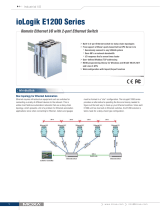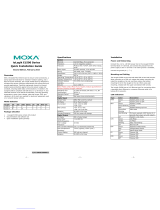
Table of Contents
1. Introduction ...................................................................................................................................... 1-1
Product Features ................................................................................................................................ 1-2
Package Contents ............................................................................................................................... 1-2
Product Model Information ................................................................................................................... 1-2
Product Specifications ......................................................................................................................... 1-3
Physical Dimensions ............................................................................................................................ 1-3
Hardware Reference ............................................................................................................................ 1-4
Panel Guide ................................................................................................................................ 1-4
Ethernet Port .............................................................................................................................. 1-4
LED Indicators ............................................................................................................................ 1-4
I/O Circuit Diagrams ........................................................................................................................... 1-5
DI Circuit ................................................................................................................................... 1-5
Sinking DO Circuit ....................................................................................................................... 1-5
Sourcing DO Circuit ..................................................................................................................... 1-6
DIO Circuit ................................................................................................................................. 1-7
Relay Circuit ............................................................................................................................... 1-8
AI Circuit .................................................................................................................................... 1-8
RTD Circuit ................................................................................................................................. 1-8
TC Circuit ................................................................................................................................... 1-9
2. Initial Setup ...................................................................................................................................... 2-1
Hardware Installation .......................................................................................................................... 2-2
Mounting .................................................................................................................................... 2-2
Grounding the Unit ...................................................................................................................... 2-4
I/O Channel Jumper Setting ......................................................................................................... 2-4
I/O Wiring .................................................................................................................................. 2-6
Communication Port Wiring ........................................................................................................ 2-10
Use the Cable Tie Base to Securely Route a Connected I/O Cable .................................................... 2-11
Powering Up the Unit ................................................................................................................. 2-11
ioSearch™ Installation ....................................................................................................................... 2-13
Load Factory Default Settings ............................................................................................................. 2-13
3. Using the Web Console ...................................................................................................................... 3-1
Introduction to the Web Console ........................................................................................................... 3-2
Overview ........................................................................................................................................... 3-3
Network Settings for the Web Console ................................................................................................... 3-4
General Settings ......................................................................................................................... 3-4
Ethernet Configuration ................................................................................................................. 3-4
User-Defined Modbus Addressing .......................................................................................................... 3-5
Default Modbus Address ............................................................................................................... 3-5
AOPC Server Settings .......................................................................................................................... 3-6
Tag Generation ........................................................................................................................... 3-6
I/O Settings ....................................................................................................................................... 3-8
DI Channels ................................................................................................................................ 3-8
DO Channels ............................................................................................................................. 3-10
AI Channels .............................................................................................................................. 3-12
AI Input Range ......................................................................................................................... 3-13
AO Channels ............................................................................................................................. 3-15
RTD Channels ........................................................................................................................... 3-16
TC Channels ............................................................................................................................. 3-18
Peer-to-Peer Networking ................................................................................................................... 3-19
Peer-to-Peer Settings (1-50) ...................................................................................................... 3-19
Sample Peer-to-Peer Configuration .............................................................................................. 3-20
DO Safe Mode Settings .............................................................................................................. 3-21
AO Safe Mode Settings ............................................................................................................... 3-21
SNMP .............................................................................................................................................. 3-21
SNMP Trap ............................................................................................................................... 3-21
Using SNMP .............................................................................................................................. 3-22
RESTful API Setting .......................................................................................................................... 3-26
EtherNet/IP Setting ........................................................................................................................... 3-26
System Management ......................................................................................................................... 3-27
Accessibility IP List .................................................................................................................... 3-27
Network Connection .................................................................................................................. 3-28
Firmware Update ....................................................................................................................... 3-28
Import System Configuration Settings ......................................................................................... 3-29
Export System Settings .............................................................................................................. 3-29
Change Password ............................................................................................................................. 3-29
Load Factory Defaults ........................................................................................................................ 3-30
Save/Restart .................................................................................................................................... 3-30






















